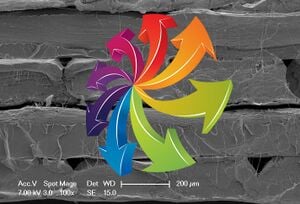
As the number of prosumer printers has expanded rapidly, they now make up the majority of the 3-D printer market and of these printers those in the open-source lineage of the RepRap also have expanded to dominate. Although still primarily used for prototyping or hobbyist production of low-value products, the RepRap has the capacity to be used for high-value distributed manufacturing. A recent study found that RepRap printed parts printed in realistic environmental conditions can match and even out perform commercial 3-D printers using proprietary FDM in terms of tensile strength with the same polymers. However, tensile strengths of the large sample set of RepRap prints fluctuated. In order to explain that fluctuation and better inform designers on RepRap print properties this study determines the effect of color and processing temperature on material properties of Lulzbot TAZ deposited PLA in various colors. Five colors (white, black, blue, grey, and natural) of commercially available filament processed from 4043D PLA is tested for for crystallinity with XRD, tensile strength following ASTM D638 and the microstructure is evaluated with environmental scanning electron microscope. Results are presented showing a strong relationship between tensile strength and percent crystallinity of a 3-D printed sample and a strong relationship between percent crystallinity and the extruder temperature. Conclusions are drawn about the effects of color and processing temperature on the material properties of 3-D printed PLA to promote the open-source development of RepRap 3-D printing.
Keywords[edit | edit source]
Mechanical Properties; Distributed Manufacturing; RepRap; Plastic Color; Crystallinity
See also[edit | edit source]
- Tensile Strength of Commercial Polymer Materials for Fused Filament Fabrication 3-D Printing
- Open source rapid prototyping of OSAT
- RepRap Mechanical Testing Literature Review
- Mechanical properties of 3-D printed truss-like lattice biopolymer non-stochastic structures for sandwich panels with natural fibre composite skins
- Tensile test protocol: MOST
- Viability of Distributed Manufacturing of Bicycle Components with 3-D Printing: CEN Standardized Polylactic Acid Pedal Testing
- Environmental life cycle analysis of distributed 3-D printing and conventional manufacturing of polymer products
- Recyclebot
- Life cycle analysis of distributed recycling of post-consumer high density polyethylene for 3-D printing filament
- Recyclebot on RepRap wiki
- Mechanical testing of polymer components made with the RepRap 3-D printer
- Development and feasibility of applications for the RepRap 3-D printer
- Life cycle analysis of distributed polymer recycling
- Solar powered distributed customized manufacturing
- MOST RepRap Build
- Life cycle analysis of distributed polymer recycling
- Improved model and experimental validation of deformation in fused filament fabrication of polylactic acid
- A few ways to strengthen 3D printed parts - STEP 3D (really nice summary of methods to strengthen parts)
- Chemical Compatibility of Fused Filament Fabrication-based 3-D Printed Components with Solutions Commonly Used in Semiconductor Wet Processing
- Compatibility of 3-D printed devices in cleanroom environments for semiconductor processing
- Mechanical Properties of Ultraviolet-Assisted Paste Extrusion and Postextrusion Ultraviolet-Curing of Three-Dimensional Printed Biocomposites
- Vacuum Outgassing Characteristics of Unpigmented 3-D Printed Polymers Coated with ALD Alumina
- Understanding the multilevel phenomena that enables inorganic atomic layer deposition to provide barrier coatings for highly-porous 3-D printed plastic in vacuums





